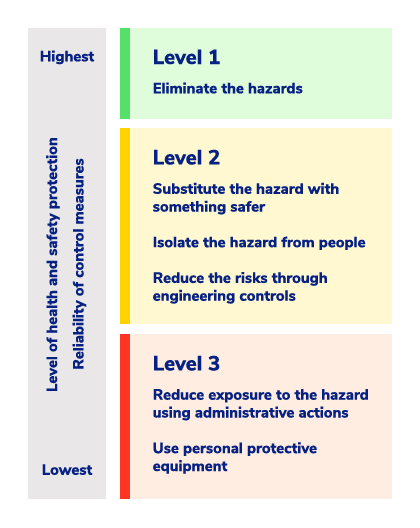Assess Different Risks and Protect Your Staff
Maintaining a safe and secure work environment is paramount for any organization. As an employer, it is your responsibility to assess potential risks and implement measures to keep your employees safe. Workplace safety not only protects your employees from harm but also fosters a positive work culture, boosts productivity, and minimizes legal and financial liabilities. Here are some of the key steps to assess risks and ensure the safety of your employees at work. By following these guidelines, you can create a secure environment that promotes employee well-being and protects your organization.
Understand Applicable Laws and Regulations
Familiarize yourself with the local, national, and international laws and regulations that govern workplace safety. Each region may have specific requirements and standards that you must adhere to. Stay updated on changes in regulations and ensure compliance to avoid penalties and legal issues. Understanding the legal framework will provide a foundation for assessing risks and implementing appropriate safety measures. Additionally, it is important to keep records of compliance with regulations and conduct regular audits to ensure that safety protocols are being followed consistently.
Conduct a Comprehensive Risk Assessment

Start by conducting a thorough risk assessment of your workplace. Identify potential hazards, such as slippery floors, faulty equipment, or inadequate lighting. Evaluate the likelihood and severity of each risk and prioritize them accordingly. Engage employees in the assessment process to gather their insights and observations. This collaborative approach enhances awareness and fosters a culture of safety within your organization. Furthermore, consider involving safety experts or consultants to provide specialized knowledge and expertise in identifying risks and implementing preventive measures.
Implement Safety Equipment and Protective Measures
Provide appropriate safety equipment and personal protective gear to employees based on the identified risks. This may include items such as helmets, goggles, gloves, and safety harnesses, but also things like a water-resistant jacket that might be crucial in certain industries and with lots of different employees. Ensure that the equipment is in good condition, regularly inspected, and replaced when necessary.
Train employees on the proper use and maintenance of safety equipment to maximize their effectiveness. Encourage a culture of compliance by enforcing the use of safety equipment and regularly conducting spot checks to ensure that employees are utilizing them correctly. By prioritizing the provision of safety equipment and protective measures, you demonstrate your commitment to employee safety and reduce the risk of workplace accidents or injuries.
Develop Clear Safety Policies and Procedures
Establish clear safety policies and procedures that address identified risks and outline safety protocols for different scenarios. Communicate these policies to all employees and provide training on their implementation. Ensure that employees understand their roles and responsibilities in maintaining a safe work environment. Regularly review and update safety policies to reflect evolving risks and best practices. By having well-defined safety protocols, employees will have clear guidelines to follow, reducing the potential for accidents or incidents.
Provide Adequate Safety Training

Invest in comprehensive safety training programs for all employees. Train them on hazard identification, safe work practices, emergency procedures, and the proper use of safety equipment. Regularly reinforce training through workshops, drills, and ongoing communication. Encourage employees to ask questions, provide feedback, and report safety concerns promptly. Consider incorporating different training methods, such as interactive workshops or online modules, to cater to different learning styles and ensure that the information is effectively retained. By providing adequate safety training, you empower employees to take an active role in maintaining their own safety and the safety of their colleagues.
Maintain a Clean and Organized Workplace
A clean and organized workplace is crucial for minimizing risks. Implement regular cleaning schedules and ensure that work areas are clutter-free. Promote good housekeeping practices, such as proper waste disposal and the use of storage systems. Regularly inspect and maintain equipment to ensure proper functioning. Create a culture of cleanliness and organization by involving employees in maintaining their workspaces and providing resources such as cleaning supplies and storage solutions. By maintaining a tidy and well-organized environment, you reduce the chances of accidents and injuries caused by tripping, falling objects, or equipment malfunctions.
Encourage Open Communication and Reporting
Create a culture that encourages open communication and reporting of safety concerns. Establish channels for employees to report hazards, near misses, and accidents without fear of retribution. Actively listen to employee feedback and promptly address safety concerns. Regularly communicate safety updates, share incident reports, and recognize employees for their contributions to maintaining a safe work environment. Encourage employees to actively participate in safety discussions, provide suggestions for improvements, and involve them in safety committees or regular safety meetings. By fostering an environment of open communication, you empower employees to play an active role in identifying and mitigating potential risks.
Conduct Regular Safety Inspections and Audits
Schedule regular safety inspections and audits to identify potential risks and ensure compliance with safety protocols. Engage trained safety professionals or appoint internal safety officers to conduct inspections. Document findings, track corrective actions, and follow up on implementation. Regular inspections help identify recurring issues and areas for improvement, allowing you to proactively address potential risks. Additionally, consider conducting surprise inspections to ensure ongoing compliance and maintain a vigilant safety culture.
Promote Employee Wellness and Mental Health Support
Recognize the importance of employee well-being and mental health in maintaining a safe work environment. Provide resources and support for employees’ physical and mental well-being. Offer wellness programs, access to mental health services, and promote work-life balance. Encourage breaks, exercise, and healthy habits. Consider implementing employee assistance programs (EAPs) that provide confidential counseling services and resources for employees facing personal or work-related challenges. When employees feel supported and cared for, they are more likely to prioritize safety and contribute to a positive and safe work environment.
Assessing risks and maintaining a safe work environment is a crucial responsibility for employers. By following the steps outlined in this article, you can protect your employees from harm, foster a positive work culture, and minimize legal and financial liabilities. By prioritizing employee safety, you demonstrate your commitment to their well-being and create an environment where they can thrive. Ultimately, a safe workplace not only protects your employees but also contributes to the overall success and reputation of your organization.



